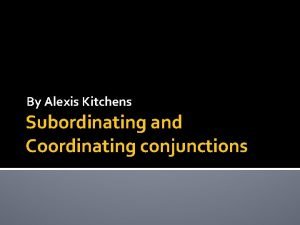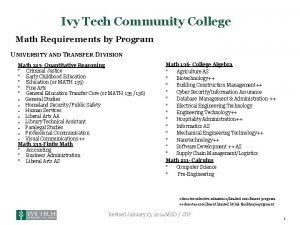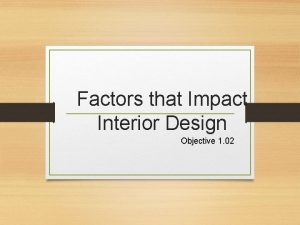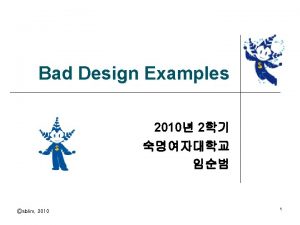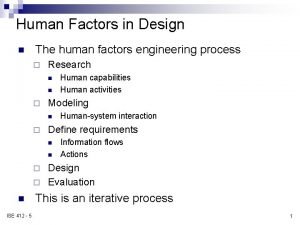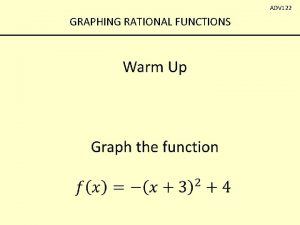INAR 122 HUMAN FACTORS KITCHENS KITCHENS l A


































































- Slides: 66

INAR 122 HUMAN FACTORS KITCHENS

KITCHENS l A kitchen, is a room or part of a room used for food preparation including cooking, and sometimes also for eating and entertaining guests, if the kitchen is large enough and designed to be used that way.

A kitchen is used for the storage and preparation of foods and contains the following equipment: ¡ ¡ ¡ sink or other device for dishwashing, stove or other device for cooking, refrigerator or other device for cold storage of food, cabinets or shelves for storage of equipment and utensils, and counter or table for food preparation.

Although the main function of a kitchen is supposed to be cooking or preparing food, the kitchen can be the center of other activities as well. l If, the home does not have a laundry room, but instead has a washing machine and possibly a dryer in a closet in the kitchen, then washing and drying laundry may also be done in the same room. l

The kitchen may be the place where the family eats, provided it is large enough and has a table and chairs. Sometimes, the kitchen is the most comforting room in a house, in this respect a large modern kitchen is still the psychological l "hearth" of the home. l

Kitchen Design The height of a kitchen workcounter, the proper clearance between cabinets or appliances for circulation, the accessibility to overhead or undercounter storage, and proper visibility are among the primary considerations in the design of cooking spaces. l All must be responsive to human dimension and body size if the quality of interface between the user and the components of the interior space are to be adequate. l

The golden triangle l There are many variations of the 'golden triangle' principle of kitchen design, but the main principle is that ¡ the most used equipment and work areas should be grouped together to allow the user to operate effectively and efficiently while cooking. The problem with the triangle theory is that individuals rank their most used equipment differently. Some would choose the cooker, refrigerator and sink, others might add a dishwasher or microwave as their most used items. l It's unlikely that the plumbing for a sink or dishwasher could be altered easily, so these items should anchor the 'triangle'. l

Working triangle l The concept of “work triangle” was developed in the 1950’s and researchers developed the “kitchen triangle” from this point.

Ergonomic planning in the kitchen is based around three main activity points: l l 1. Sink 2. Fridge 3. Cooking area These areas make up what is known as the “working triangle” since together, these points create a triangle of activity. The idea is that the distance between these major areas should not be too great for reasons of convenience and safety. (Mutfakta çalışma alanını merkezi hale getirip daha az hareketle daha çok alana ulaşabilmeyi sağlamak için yapılan düzenlemeye “mutfak üçgeni” denir. ) l Solutions include placing: ¡ ¡ l the refrigerator within reach of a worktop and, placing the dishwasher close to the sink. Similarly, counters and cabinets need to be at the right height and usable by right- and left-handed cooks. Heavy pots should be stored in a place that’s easily accessible, while small appliances should be at the correct height. These details are engineered to protect your back from injury.

The Kitchen Triangle l The kitchen triangle is a design concept where the fridge, stove and sink are aligned in a triangle. This allows for the preparation area to never be far from the washing area and cooking surfaces making all components of the kitchen easily accessible. ¡ l Used properly, it is possible to not take more than a step, or a few, at any point, not to change a person’s location or use a different appliance in the workspace. Appliances should not be spaced too close together. ¡ By doing so the appliance doors may not be able to open properly. This can also dramatically reduce the counter space.

l The triangle should total not more than 790 cm, with no single leg being shorter than 120 cm or longer than 270 cm. x > 120 cm Max. 790 cm x < 270 cm

Types of Kitchen Layouts l Each kitchen is designed through the use of a standard layout. These layouts have been around for decades and were designed to fit particular spaces. These are namely: ¡ Single line, ¡ Galley / Corridor, ¡ L-shaped, ¡ U-shaped, ¡ Peninsula, and ¡ Island

l Today most homes are designed similarly and these layouts continue to be used in today's kitchen designs. Of course if space and money is no object, any design can be achieved!

Corridor /Galley L - shaped Peninsula U - shaped

Galley / Corridor Kitchen l The Galley design or Corridor kitchen is common in many apartments and open concept layouts.

Galley / Corridor Considerations: Space is limited so counter space should be optimized or consolidated. l Appliance location is important. When opened, appliances should not block any exits or not be able to open fully because of cabinetry. l Pull out wall cabinets should be used to conserve space. l Space economy should be achieved with floor and wall cabinetry and overhead microwaves should be planned or the new models that pull out like drawers should be looked for. l l

Galley Row Measurement l For a galley kitchen layout, ensure that there is at least 120 cm between the two facing rows of cabinets – so you have room to prepare food.

Single line / Wall l In a single line kitchen, the working triangle stretches into a straight line. It can cause the longest journey distances between the chief activity areas. Situating the sink in the middle of the line can help reduce these journeys.

L Shaped Kitchen l. L Shaped kitchen designs are great for small spaces and open concept rooms. This design locates all appliances and counter space along two walls in the corner of the kitchen space at approximately a 90 degree angle. An L shaped kitchen design allows for a compact workspace while freeing up much needed space for a dining area or storage.

L-shaped l The L-shaped kitchen is a very popular layout – ideal for a family kitchen or for entertaining guests as it its layout can easily accomodate dining and living areas in the same room. The hob, fridge and sink should ideally be separated by a length of worktop for preparation.


U Shape Kitchen l A U-shaped kitchen design usually has one entrance and all counter space and appliances are built into a U shape. U-shape kitchens are often designed with a view through wall or opening between rooms. This effect is great for small spaces such as condominiums or apartments as it will open up your kitchen to the rest of your home. If you are planning a U-shaped kitchen design where an opening exists in a wall, be aware to not sacrifice cupboard space and electrical outlets when taking that wall out. If you are unsure whether this wall is a retaining wall refer to your buildings designs or better yet seek professional advice.

U-shaped

Island Kitchen l Island Kitchen designs take the L shaped kitchen design to a new level. By adding an island to an existing L shaped layout, you can effectively create a kitchen triangle concept while not taking away from the open concept so popular with today's modern kitchen planning. Island Kitchens are very trendy right now and are great for entertaining guests.

l You can use your island as a feature point to your room, as an eating/ bar area or as a cooking area. The Island kitchen design gives you great freedoms to express your own individuality in your home. A properly placed island in a U-shaped kitchen can help in creating more counter space, a unique cooking area or innovative dining option. An island does not have to be a static piece either. There are many floating islands available today on wheels so that they can be anywhere you want them to be! Floating islands are a great option if more storage and space is needed. Consider the island design if your space can accommodate one.

Single line + island l If you have a lot of space, consider a singleline kitchen with an island unit. This provides an optimal arrangement for the working triangle as everything is easily reached. The whole kitchen can feel very open and perfect if you plan to do some entertaining.



Universal Kitchen l Universally designed kitchens are the most functional ones, but require quite the advanced planning. The premise of these kitchens is ease of use by taking all human qualities such as size, age, and health into perspective when designing a kitchen. A universal kitchen should allow for any user to easily work in the environment around them. Accessibility, location of appliances, handles for the elderly or handicapped, easily opened doors, adequate lighting, error free planning and the ability to function under any circumstance are the paramount features to a universally designed kitchen. This is a great design choice if you live with a disability or entertain often and have multiple users, such as in a rental property or shared kitchen.

Room For The Range Measurement l Here a minimum of 45 cm from the cooktop to a wall or fridge panel is recommended, for hot pans to be safely rested down.

Between Range And Sink Measurement l If possible, allow a width of at least 60 cm of countertop space between the cooktop and sink – for food preparation, and for resting the hot pans

Extractor Fan Measurement l It is recommended that you allow 60 cm or more in height between your cooktop and extractor fan (with gas needing more space than electricity). See the manufacturers specifications of your extractor fan to be sure.

Dishwasher and Sink l If you want a dishwasher, the best location for it is right next to the sink. This makes installation simpler, and perfectionists can satisfy thier urge to pre-rinse their mucky dinner plates.

Oven Eye Level

Filler Piece

Heights and depths l Counter height should be between 76 – 86 cm. l The depth of the counter should be min. 60 cm. l Counter height with sink should be between 92 – 107 cm l For a comforable use of appliances and furniture, working surface should be 120 cm long.

Heights and depths Lower cabinets: for big and heavy or less used kitchen utensils. HXWXD: 85 x 20 -60 x 60 l Upper cabinets: Should not be too deep so that the space beneath can be used with ease. HXWXD: 35 x 20 -120 x 35 l High and side cabinets: For refrigerator, stove or oven to be placed between them, cabinets for cleaning, broom or pantry should be accessible. HXWXD: 203 x 45 -60 x 40 -60 l

Spacing for furniture and Appliances l Cooking area: 60 cm. l Washing area: two sinks + rinsing area: 150 cm. l Oven, stove, refrigerator: 60 cm for each. l Lower cabinet, preparation area, and stacking area for plates, ladels, small appliances and utensils : 200 cm.

Minimum dimensions for circulation in the kitchen l Distance between 2 work surfaces: 120 cm. l Clearance to bend and pick something from the oven: 135 cm. l Clearance between table and wall: 60 -100 cm l Space for drawers and cabinets: 40 cm.

l Mechanical ventilation above the stove should be: 90 cm. l For ease of use with electrical utilities, there should be a sufficient amount of secure power sockets. l Another method that enhances comfortable use of the kitchen is to place stacking area (istif yeri), oven, preparation area, washing area, drying area from right to left. The dishwasher should be placed to the right or left of the sink.

Dining tables Round tables are more convenient, dining table with right angles take less space. l There should be a space around 20 cm at the center of the table for pots and crockery. l There shouldnt be any glare on the eating surface. l Distance between the table surface and lights should not be less than 60 cm. l l The area necessary for 1 person to eat comfortably is: 60 x 40 cm.




l Designers Melanie Olle and Ilja Oelschlagel's Grandma's Kitchen concept is a compact unit that unravels to offer a plethora of functions. The seemingly flat, elevation-like panel folds, extends and opens to reveal a functional kitchen and dining area complete with dishwasher, chopping area, oven, refrigerator, table, chairs, and lamp.




Kitchen Lighting l Kitchen lighting is an important part of any kitchen design. In order to be effective in the kitchen, you need to be able to see well. Though the need for lighting in this area is obvious, choosing the right lighting can be very confusing for many. l Does the kitchen get any natural light? Does it catch morning, afternoon or evening sun? Are there shadows cast? If there is no natural light how is light brought to the work space? What type of lighting fixtures will be used and what type of bulb will they require? l Consider using under cabinet or inset lighting for countertops. Pot and recessed lighting can create a soft light and combined with dimmers will provide adequate task lighting and fantastic ambiance. Xenon lighting is replacing halogens as a softer alternative to help eliminate the shadow effect traditionally cast by halogen bulbs.

When it comes to kitchen lighting, the most common mistake is trying to light the entire room with one ceiling-mounted fixture. The result ends up being a "glare bomb, " which visually overpowers everything in the space. l No single light source can provide all the necessary light for a kitchen. A well-lit kitchen layers and blends four different types of light. l

FOUR TYPES OF ILLUMINATION l Every kitchen design should include the following: ¡ Task Lighting. It is the workhorse of illumination and provides adequate light for tasks like chopping vegetables and reading recipes. Optimum placement of task lighting comes between a person's head and the work surface, which makes lighting located below the upper cabinets so effective. If a kitchen design includes a pantry, make sure to specify task lighting there as well.

¡ ¡ ¡ Ambient lighting. It creates a warm glow that fills a room, softens shadows and helps to make people feel instantly welcome in a kitchen. If cabinets do not reach all the way to the ceiling, that space is a great spot for ambient light. Of the four types of lighting, ambient is most often overlooked. Accent lighting. It gives depth and dimension to a kitchen. Examples of accent lighting include fixtures placed inside glass-front cabinets to illuminate China, glassware, and other collections as well as recessed, adjustable low-voltage fixtures used to spotlight art. Decorative lighting. This type of lighting is refered to as “architectural jewelry”. It adds sparkle to a space.

DIM THE LIGHTS l As in any room in the house, the ability to adjust light levels in the kitchen is ideal. When cooking or cleaning up, a bright punch of illumination makes the job easier. For lingering over a meal and conversing, dimmed lights create great ambiance. One dimmer in the kitchen won't do the trick, however. Make sure the design calls for separate dimmers for each type of lighting: task, ambient, accent and decorative.

Kitchen Ceiling Lighting There is more than one way to light a kitchen, and ideally, a combination of techniques should be used. Kitchen ceiling lighting should be combined with lighting positioned in other areas, to create the proper flow and brightness. l Typically a combination of ceiling fixtures, undercabinet lights, and often track lighting is necessary to create an effective lighting scheme that is both functional and decorative. l

Illuminate Your Counter Tops with Under Cabinet Lighting When working in the kitchen, you need good lighting to read recipes, chop, measure, cook and clean. In the past, the light source was usually a single overhead fixture and whatever sunlight was available. l Unfortunately, time of day, the season, which direction your kitchen faces, and the number and size of windows all greatly impact the amount of natural light available. And overhead lights usually don't provide adequate illumination. That's why under cabinet lighting has become extremely popular in recent years, because of its functionality and the way it can add an attractive glow in the kitchen. l

Task Lighting Under cabinet lights provide excellent task lighting for all sorts of kitchen work, from cooking and recipe reading to cleaning and silver polishing. They can also serve as a kitchen nightlight for those late-night snackers. l Fixtures are available in mini-track systems, light strips and disc or puck-shaped lights. Most are low-profile and will be hidden from view in the recessed bottom of wall-mounted cabinets, usually below eye level. l

Under Cabinet Lighting as Accent Lighting l Under cabinet lighting comes with several bulb options: halogen, fluorescent and xenon, all of which are improvements over regular incandescent bulbs for energy efficiency and extended life. l Fluorescents were the first under cabinet lighting. They continue to be a strong seller, with their reliability and energy efficiency. Lowvoltage, halogen bulbs produce a very bright, white light which closely mimics sunlight. Xenon, another low-voltage option, runs at a cooler temperature which may be preferred in some instances. l Under cabinet lights can be set up to switch on automatically with overhead lights, or turn on independently. Installing dimmers can also create a warm ambiance when overhead lights are off.

Illuminated glass splashback / backsplash LEDs last at least 60, 000 hours. This means no access is required to a light box and because they are edge lit, they can be fitted in just the same way as a normal glass splashback with a power point attachment. l Splashbacks come with single colour illumination or full colour changing abilities that can be paused on any of the 4096 colours available. The applications for Splashbacks are boundless. Not only can they be used as splashbacks but also in shelving systems, water features, corporate signage, flooring, menu boards and entrance foyers to name just a few. Essentially, Splashbacks can be used in any application where artificial lighting can be used. l



Kitchen Island Lighting l Decorative pendant lights (asılı ışıklıklar) work wonders for lighting an island, while simultaneously adding style to your kitchen's decor. You might use a combination of two or three pendant lights over a kitchen island for an even more appealing look. A dimmer switch, used in conjunction with pendants, allows for bright task lighting to effectively brighten the area for food preparation or homework, while allowing the lights to be lowered for entertaining guests or simply to create a charming atmosphere. Fluorescent light fixtures can also be used to light a kitchen island, as can recessed lights positioned overhead. l There are many styles of pendant lights from which to choose. You can find pendant lighting to fit any type of kitchen decor. Mini pendants work well with kitchen islands also and can be positioned to form a fashionable row of lights.


Kitchen Colors l Colors can dramatically affect the overall look of your project. l l l Small kitchens - Try using cool colors. These colors will actually make your space look larger where warm colors will make your space seem smaller! Make you ceiling seem taller by painting it a cooler color than the walls! Large kitchens - Any color could work however really intense colors can look amazing in a large space with appropriate contrasting colors. Warm colors will also help the space feel closer together. Glossy - These colors and surfaces will reflect light making the color more intense. Matte - These colors and surfaces will absorb light making the color seem flat or pale. One of the most important decisions you will make in the design process is the appearance of your cabinets. They are the focal point for all kitchens so if you choose a color palette that deviates too far from your cabinetry, you will definitely experience trouble matching your countertops, appliances, back splashes and flooring. Of course a perfect match is not necessary but any great renovation is built upon a strong foundation of color and compatibility. Remember that any color you choose will be very affected by the lighting in your space.


Kitchen Flooring l You may think that the most used component of the kitchen would be an appliance however in fact it is your kitchen floor! Choosing the right kitchen floor depends on several factors. What will traffic be like? How much do you want to spend? What is the durability of each product? What designs are available? What are your flooring measurements and how much material will be required? When designing your kitchen, it is vital to include appropriate flooring materials that keep durability, style and re-sale in mind. Whether you are designing, remodeling or re-designing your kitchen research on kitchen flooring plays an enormous role as there are several materials to choose from.

 Inar tv
Inar tv Subordinating conjuctions
Subordinating conjuctions Breadlines and soup kitchens definition
Breadlines and soup kitchens definition Mandatos negativos con tu p 122
Mandatos negativos con tu p 122 Nec 250-94
Nec 250-94 Http://122
Http://122 Homework 122
Homework 122 Eecs 122
Eecs 122 Ece 122
Ece 122 Section 122(9)
Section 122(9) Math 135 ivy tech
Math 135 ivy tech Eecs 122
Eecs 122 Nec 250 122
Nec 250 122 65÷5
65÷5 Psalm 122 i was glad
Psalm 122 i was glad Ion stoica berkeley
Ion stoica berkeley Ee 122
Ee 122 Ee 122
Ee 122 Classes of airspace
Classes of airspace Psalms 68 5
Psalms 68 5 50000/122
50000/122 Hist 122
Hist 122 Round 757 to the nearest 10
Round 757 to the nearest 10 Psalm 122:5
Psalm 122:5 Nrs 122
Nrs 122 A traffic light weighing 122 n
A traffic light weighing 122 n 건설업 gdp 비중
건설업 gdp 비중 Pp 122
Pp 122 Convenio 122 oit
Convenio 122 oit You buy a package of 122 smarties
You buy a package of 122 smarties Ece 122
Ece 122 Ee 122
Ee 122 Articulo 197 lottt
Articulo 197 lottt Psalm 122:1-9
Psalm 122:1-9 Harga 3 lusin pensil rp45.000 harga 32 pensil adalah
Harga 3 lusin pensil rp45.000 harga 32 pensil adalah In ip addressing, an address beginning with 122 is
In ip addressing, an address beginning with 122 is Frc pneumatics
Frc pneumatics Dns example
Dns example 122 design
122 design Site vs situation examples
Site vs situation examples Abiotic factor
Abiotic factor Abiotic vs biotic factors
Abiotic vs biotic factors Abiotic factors and biotic factors
Abiotic factors and biotic factors Biotic and abiotic
Biotic and abiotic Site vs. situation
Site vs. situation Common factors of 8 and 36
Common factors of 8 and 36 7-1 factors and greatest common factors
7-1 factors and greatest common factors Factors of 56
Factors of 56 Human movement science impact factor
Human movement science impact factor Project evaluation and control
Project evaluation and control Human factors theory
Human factors theory Shell model human factors
Shell model human factors Fnaeb
Fnaeb Human factors in interior design
Human factors in interior design Social factors affecting human resource management
Social factors affecting human resource management Define enviromental health
Define enviromental health Human factors design guidelines
Human factors design guidelines Bad mapping design examples
Bad mapping design examples Human factors instructor
Human factors instructor Dirty dozen human factors nederlands
Dirty dozen human factors nederlands Factors affecting human resource management
Factors affecting human resource management Lmq human factors model
Lmq human factors model Martin bromiley
Martin bromiley 4 factors facilitating communication
4 factors facilitating communication Human resource management activities
Human resource management activities Factors of hci
Factors of hci Caa human factors
Caa human factors

